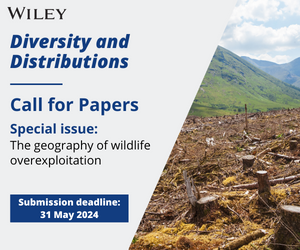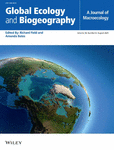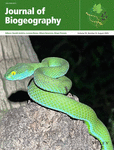Overview
Diversity and Distributions was launched in 1998 and publishes twelve issues a year.
In 2019, Diversity and Distributions transitioned to an Open Access model. The journal does not charge any submission fees. To find out more about the journal’s Article Publication Charges, click here.
Aims and Scope
Diversity and Distributions is a journal of conservation biogeography. We publish papers that deal with the application of biogeographical principles, theories, and analyses to problems concerning the conservation of biodiversity. Appropriate topics include identifying the agents of global change, including how climate change, land use change, overexploitation, pollution and invasive species affect the abundance, distribution, spatial genetic composition and range boundaries of species; innovative applications or methods of species distribution modelling and individual-based modelling with applications in conservation biogeography; the application of island biogeographic principles to conservation; phylogeographical or landscape genetics/genomics studies with clear conservation implications; developing paradigms, models and frameworks for conservation planning and risk assessment; investigating ecological and anthropogenic factors favouring the emergence of infectious diseases (EIDs).
Papers must meet five criteria to be considered for publication:
(1) they must have a strong biogeographic focus with a clear conservation implications outlined in a dedicated 'conservation implications' section in the discussion, or a strong conservation or global change focus related to biogeographic patterns or principles. Conservation implications can also relate to conservation theory. Please note that biogeography studies that are potentially informative for conservation, but where conservation implications are not well elaborated, are not a good fit for the journal. Similarly the threatened or exploited status of species (or studying sites within protected areas) in a study is not a sufficient condition to meet this criterion.
(2) submissions must derive novel insights from biogeographic patterns and processes and biodiversity status and trends.
(3) the research must be conducted across large spatial, temporal or taxonomic scales, and results - or methodological approaches proposed - must be relevant beyond the specific study system.
(4) results must have clear and important implications for our understanding of biogeography or conservation and must be of potential broad interest to the readership.
(5) they must have a solid theoterical underpinning, a clear study design and robust methods, and the findings must be presented clearly and concisely.
* Please note that biogeography studies that are potentially informative for conservation, but where conservation implications are not well elaborated, are not a good fit for the journal. Similarly, the threatened status of species in a study is not a sufficient condition to meet criterion number 1.
Diversity and Distributions is a sister publication to Journal of Biogeography and Global Ecology and Biogeography. The three journals have distinct but complementary focus areas within the broad field of biogeography.
The Journal of Biogeography publishes research at the intersection of biology and geography that is scientifically important and of broad general interest. We seek papers describing patterns and revealing mechanisms that shape biodiversity, through time, throughout the planet, from the deep past into the future, and from local to global scales. Diverse approaches are encouraged—including ecological, evolutionary, genomic, geographic, empirical, theoretical —considering any aspect of biogeography, from molecules to ecosystems and from microbes to plants and megafauna. Through this broad and inclusive scope, we aim for papers in Journal of Biogeography to address understudied, vexing, and urgent questions and to advance basic understanding of the origins, distributions, and fates of life on Earth. Manuscripts submitted to Journal of Biogeography should be original and innovative, concise, well written, rigorously analyzed and argued, and consequential. While many such studies will be multifaceted, comparative, and draw generalities, we also welcome exceptional case studies that illustrate particularly interesting deviations that, in their aggregate, shift preconceptions. The Journal of Biogeography is edited and reviewed for the community by a team of practising biogeographers. We support open data, accessibility to publish and read, and a constructive peer-review process.
Global Ecology and Biogeography (GEB) welcomes papers that investigate broad-scale (in space, time and/or taxonomy), general patterns in the organization of ecological systems and assemblages, and the processes that underlie them. In particular, GEB welcomes studies that use macroecological methods, comparative analyses, meta-analyses, reviews, spatial analyses and modelling to arrive at general, conceptual conclusions. Studies in GEB need not be global in spatial extent, but the conclusions and implications of the study must be relevant to ecologists and biogeographers globally, rather than being limited to local areas, or specific taxa. Similarly, GEB is not limited to spatial studies; we are equally interested in the general patterns of nature through time, among taxa (e.g., body sizes, dispersal abilities), through the course of evolution, etc. Further, GEB welcomes papers that investigate general impacts of human activities on ecological systems in accordance with the above criteria. Global Ecology and Biogeography generally does not publish studies that focus on unique events or places, or on specific taxa in local areas. The journal is also not interested in studies that lack ecological and/or biogeographical focus
Keywords
Diversity and Distributions, biodiversity, biogeography, ecology, economics, endangered species, ethics
Indexing Information
- Abstracts on Hygiene & Communicable Diseases (CABI)
- Academic Search (EBSCO Publishing)
- Academic Search Alumni Edition (EBSCO Publishing)
- Academic Search Premier (EBSCO Publishing)
- AgBiotech News & Information (CABI)
- AgBiotechNet (CABI)
- AGRICOLA Database (National Agricultural Library)
- Agricultural & Environmental Science Database (ProQuest)
- Agricultural Engineering Abstracts (CABI)
- Animal Breeding Abstracts (CABI)
- Astrophysics Data System (Smithsonian Astrophysical Observatory)
- BIOBASE: Current Awareness in Biological Sciences (Elsevier)
- Biocontrol News & Information (CABI)
- Biofuels Abstracts (CABI)
- Biological Abstracts (Clarivate Analytics)
- Biological Science Database (ProQuest)
- BIOSIS Previews (Clarivate Analytics)
- CAB Abstracts® (CABI)
- Crop Physiology Abstracts (CABI)
- Current Contents: Agriculture, Biology & Environmental Sciences (Clarivate Analytics)
- Directory of Open Access Journals (DOAJ)
- Environment Index (EBSCO Publishing)
- Field Crop Abstracts (CABI)
- GEOBASE (Elsevier)
- Global Health (CABI)
- Grasslands & Forage Abstracts (CABI)
- Helminthological Abstracts (CABI)
- Horticultural Science Abstracts (CABI)
- InfoTrac (GALE Cengage)
- Irrigation & Drainage Abstracts (CABI)
- Journal Citation Reports/Science Edition (Clarivate Analytics)
- Leisure Tourism Database (CABI)
- Leisure, Recreation & Tourism Abstracts (CABI)
- Natural Science Collection (ProQuest)
- Nematological Abstracts (CABI)
- Nutrition Abstracts & Reviews Series B: Livestock Feeds & Feeding (CABI)
- Ornamental Horticulture (CABI)
- Plant Breeding Abstracts (CABI)
- Plant Genetic Resources Abstracts (CABI)
- Postharvest News & Information (CABI)
- Poultry Abstracts (CABI)
- ProQuest Central (ProQuest)
- ProQuest Central K-143
- Protozoological Abstracts (CABI)
- Research Library (ProQuest)
- Research Library Prep (ProQuest)
- Review of Agricultural Entomology (CABI)
- Review of Medical & Veterinary Entomology (CABI)
- Review of Medical & Veterinary Mycology (CABI)
- Review of Plant Pathology (CABI)
- Rice Abstracts (CABI)
- Science Citation Index Expanded (Clarivate Analytics)
- SciTech Premium Collection (ProQuest)
- SCOPUS (Elsevier)
- Seed Abstracts (CABI)
- Soils & Fertilizers Abstracts (CABI)
- Soybean Abstracts Online (CABI)
- Tropical Diseases Bulletin (CABI)
- Veterinary Bulletin (CABI)
- Weed Abstracts (CABI)
- World Agricultural Economics & Rural Sociology Abstracts (CABI)
- Zoological Record (Clarivate Analytics)








